| Food and Cooking Onboard | |
| Before I moved onboard Sarah
full-time I thoroughly enjoyed cooking, for friends or just myself.
Much of this cooking was in a condominium with a relatively large
kitchen, and many cabinets to store all my cooking toys. When
I moved onboard I had to drastically reduce the number of cooking
toys to the absolute minimum. I also had to develop new
cooking techniques due to the limitations of a sailboat galley.
Initially I didn't do a very good job of downsizing my cookware
inventory. I just couldn't do away with a pot or pan that had
served me well for years, but now could be replaced by a more
multi-functional item. So for the first few years of cruising and living onboard I carried a lot of cookware I rarely used. I also had multiples of the same pot or pan. Well, isn't having a backup an essential part of off-shore sailing? Now (2008), 5 years into living onboard I'm finally starting to get myself organized in the galley. I've focused on a few items that are the most useful to my cooking and am starting to remove those items I really liked having, but rarely used and for which there is another option. The purpose of this page is to share some of the cooking tools I've found optimal for on-board cooking and cruising. |
|
| Cookware & Utensils | |
| Saute Pan - Then Saucier Pan - Now Saute Pan | |
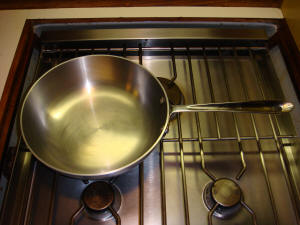 All-Clad 3qt Saucier (Chef's Pan) |
The
one pan I almost always reached for when starting to cook in the
evening was my All-Clad 3qt. Saucier. This was my all-purpose
pan for the stove top. I once thought a Saucier was just a fancy looking sauce pan. However with its rounded and deep sides I have learned that it can perform many functions. It can saute, fry, braise, stew and it can even go in the oven. It is not the perfect pan for browning meat, so I keep at least one fry pan for that purpose. |
|
The 3 qt. size fits perfectly on any of the three burners of my Force 10 stove. This size is large enough for a one-pot meal for a crew of 3-4 when sailing off-shore, but also works well when I'm cooking for just myself. Well, maybe not that well for myself as I tend to fill it as full of food then as when I'm cooking for a crew. All-Clad is very pricey, but I found an Internet Retailer, Cookware & More, that sells All-Clad Irregulars at a 33% discount. I also have a smaller (2 qt.) stainless steel Saucier by Green Pan. I've been using it a lot lately. I guess I'm getting a little more responsible when it comes to portions. |
|
| The 3qt Saucier remained my most useful pan for nearly 10 years. The main reason for this was because it was the only large pan that fit the main burner on my Force10 stove. If you look at the picture above you will see that the main burner was on the back of the cook top, and the surface area was impinged by the sheet metal cover for the oven vent at the back. I originally had a 3 qt saute pan, but the vent cover prevented it from being centered over that main burner. The saucier, with its curved sides and smaller bottom fit perfectly on this burner. I gave the saute pan to a friend and just used the saucier. | |
|
Then in 2014 my Force10 stove started to have numerous problems and
I replaced it with a
new Force10. With the newer model Force10 has moved the
main burner to the front of the stove (where it always should have
been) and now that 3 qt saute pan would have fit perfectly. So
I puchased a new tri-ply saute pan from
Sur la Table
for about 1/3 the price of the similar All Clad saute pan. The
large flat bottom of saute pan is much more stable on a swinging
stove than that of the saucier pan. Now this is now my go to pan, and I have given away the saucier pan. |
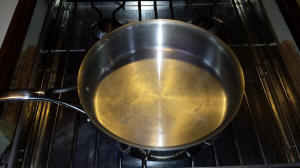 Sur la Table 3 qt Saute Pan |
| Braiser | |
|
A
Braiser is piece of cookware I seldom used when cooking ashore, but
now I use it often. It is my all-purpose roasting pan, but it
can also be used on the stove top like a Dutch Oven. I've used
this Braiser to roast duck and chicken, make pot roast, crab
bisque and many other dishes for which in the past I had individual
pans. In paticular I've used this pan to roast a small (9 lb)
turkey when I've been the family host for Thanksgiving. I am a great fan of pressure cookers (see below), but I really prefer a pot roast slowly cooked in this Braiser for several hours to one made in less than an hour in a pressure cooker. This enameled, cast-iron Braiser was purchased at Wal-Mart for less than $40. |
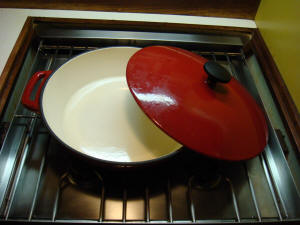 Tremontina Braiser |
| Pressure Cooker | |
| I certainly would not want to go cruising without a pressure
cooker. This is the great energy saver as well as cooker of
cheap and tough cuts of meat. When coastal cruising or dockside I enjoy the luxury of slow cooking meats in the oven, but when I am far from a Propane source the pressure cooker comes out. My cooker is a T-FAL pressure cooker. Probably the only thing I've ever purchased from an infomercial on TV. When I saw this item advertised I saw an immediate application for onboard cooking. I previously had the standard Presto Pressure cooker with the round pressure weight. That was really a good cooker, however the weight had been miss-placed, and the aluminum pot was starting to get pitted. |
|
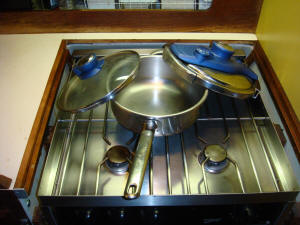 T-FAL Pressure Cooker |
The appeal of the T-FAL cooker was no weight and all stainless steel and plastic so no concerns about corrosion or pitting. A further appeal was it came with two pots. The smaller pot shown in the picture is a 3 qt. chicken fryer when not being used as a pressure cooker. There is a glass cover on the left side of the cooker. The pressure cooker lid is on the right. The additional pot is a 6 qt pot (not shown). I rarely used that pot for pressure cooking. It was my stock pot, but when I added the thermos cooker I ended up with two stock pots and gave away the pressure cooker bottom. |
| The t-Fal cooker served me well for over 20
years, but eventually drops and other dings took their toll on the
cooker top, and the pressure control valve became non-functional.
I had plenty of better pans than the 3qt bottom as a chicken fryer
(a rare use). so I got rid of the T-Fal and replaced it with a
Calpalon 6 qt pressure cooker. This is a larger pot than I
really want and is hard to store on a boat. I would have
preferred that same chicken fryer size pot, but I could not find on
online, even on the T-Fal web site. By late 2017 my detriotating health had kept me dockside for over 3 years and my lifestyle had become much less oriented toward crusing and more to just living onbaord (see the page on Sous Vide). Although I prefer cooking over flame, I could see the appeal of an induction burner when ample shore power is available. So I bought a NuWave Induction Cooker to suppliment cooking over flame. The pressure ooker is sitting on the NuWave in the picture on the right. |
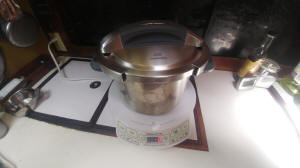 Calpalon 6qt. Pressure Cooker, on NuWave Induction Cooker |
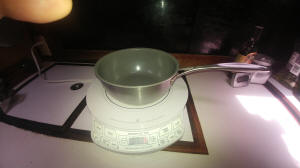 Green Pan 2 qt. Saucier on NuWave Cooker |
The Induction cooker is great for slow cooking or pressure cooking as the temperature control is much more precise and I'm not using up my propane supply. I still use the gas cooktop for active cooking where I will pick up the pan and shake it to redistribute and mix the contents. The induction cooktop gets real upset when I do that. To the induction cooktop is my slow cooking heat source and the gas cooktop is for all other cooking. The picture on the left also shows the Green Pan Saucier I bought around the same time as the NuWave cooker, and mentioned above. The NuWave turned out to be of less quality than I hoped and failed within a year. By then I had become a frequent user of the cooker and replaced with it with another by EuroKitchen. Time will tell if this is another unreliable applicance. |
| Silicone Cookware | |
| One
of the new cookware items I've only recently (2007) discovered is Silicone
bake ware. This is an ideal solution for onboard cooking.
I rarely bake bread, but early last year (2007) when I decided to use a
loaf pan to make meatloaf, I discovered that all the of the metal pans I
had onboard were badly corroded and pitted. Shortly after arriving back in the USA I was shopping in the Target store in California, MD and discovered the new world of Silicone bake ware. I purchased two loaf pans and cooked meat loaf that evening. This is a great solution for onboard cookware. No possibility of corrosion and the pans can be compressed for storage. |
Silicone Loaf Pans |
| I have subsequently purchased several other silicone utensils, included a set of collapsing measuring cups, baking sheets and the trivets on which the loaf pans are resting in the picture above. | |
| Folding Colander | |
| A
colander is a necesary kitchen tool. Originally anytime I needed
to drain drain food I had to pull out a large round colander. Then it
sits there on the counter or in the sink taking up a lot of valuable
real estate until it is washed and put away. When stored it
still takes up a lot of space and doesn't easily stack with other
cooking tools. |
|
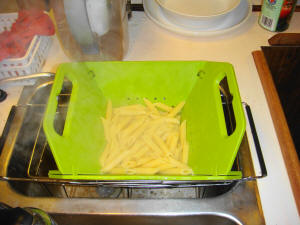 Folding Collander |
One day I noticed something called a collapsible colander for sale
on Chefs,
a cookware retail website. What the heck, it was
only $15 (a special sale price) so I ordered one. Surprisingly it is a very good colander, shown on the left in action. I was finally able to trash the other large colander I had on board. |
| On
the right, the same colander has been collapsed and washed. It
stacks nicely in the drain rack. It also stores flat and takes up
little space in a locker. It's a little thing, but it actually works well. Subsequently I purchased a small enameled collander that serves me better when cooking for just myself, but this is still the go-to collander when cooking for a crew. |
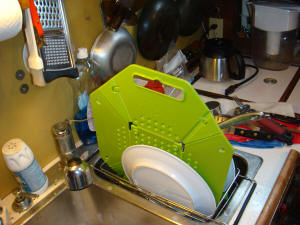 Cleaning the Collander |
| Food Mill and Ricer | |
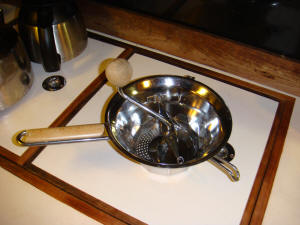 Crate & Barrel Food Mill |
I
consider a Food Mill to be the cruising man's (or woman's)
Cuisinart. If I want to puree some vegetables, especially
tomatoes I reach for this Food Mill purchased at Crate & Barrel
back in the 1980s. It is really good for vegetables that have seeds, such as tomatoes and squash. Using one of the finer strainers on the Food Mill I can puree the meat of the vegetable but retain the seeds in the mill. It is also stainless steel, another good thing. |
| I also carry a Ricer in Sarah's galley. This is probably
redundant to the Food Mill, above, but it can be much quicker and easier
if I just want to mash some potatoes or cauliflower. It is
quicker to set up and easier to clean than the Food Mill. It does a great job of making mashed potatoes from canned potatoes. No boiling the potatoes, just drop them directly from the can into the ricer then into a pan to heat with some milk/cream and butter. |
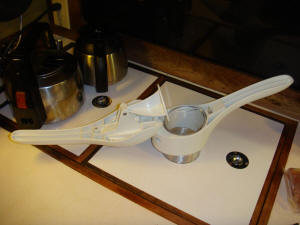 Kuhn-Rikon Ricer |
| Coffee Makers | |
|
I
am a coffee addict. Unfortunately I am also very sensitive to
caffeine, but it is really not the jolt I crave, but the flavor.
Coffee also keeps me regular ( I know more information than you
needed). For my daily morning intake I use a Melitta filter cone and a thermal carafe. That's OK in a harbor, but at sea or in a rolling anchorage it doesn't work that well. For those times I use a Coffee Press, which keeps the coffee and hot water contained during the brewing process. With the Melitta system the brewing coffee can get distributed all over the galley counter when Sarah rolls. |
|
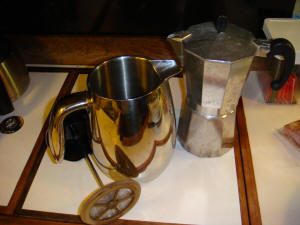 Coffee Press and Stove Top Espresso Coffee Maker |
I purchased the Coffee Press on the left in this picture from
Sur la
Table years ago. I don't remember the brand or price.
It has been a great onboard coffee maker on passages and rough
anchorages. It is a thermal carafe so it keeps the coffee warm
for an hour or more. Since it is also Stainless Steel is
pretty indestructible. To the right of the coffee press is an
aluminum
stove top Espresso maker. It is normally only used for coffee
after dinner in the evening, and then using De-Caf. I only use
French or Dark Roast coffee, no matter which coffee maker and
Caf or De-Caf. |
| Interestingly on passages, when I thought I would need the Caf to keep me awake on night watches, I seldom drink coffee. I don't know whether its the acidity or just the trouble to make, but I only make a pot of coffee every 2nd or 3rd day at sea. My normal warm drink on night watch is hot chocolate (instant). | |
| Grill Pan | |
|
A
grill pan is definitely one of those things that is not an essential
piece of onboard cooking tools. In the warmer climates, and
certainly during the summer months you do not want to be adding more
heat to the cabin with this pan. That's why they invented gas
grills. However, during the winter it is really nice to be able to grill meat rather than just fry, sauté or braise. This is a Calphalon cast iron grill pan. I've had it for about 8 months (March, 2008) and it has served me well. I guess I'll keep it for awhile longer. This is a strip loin steak. I also like to grill Salmon and Tuna steaks in this pan. The grill marks aren't just for show, they do actually add some flavor and the meat doesn't sit in the grease when cooking. I use bacon grease to season the pan and keep it from rusting. |
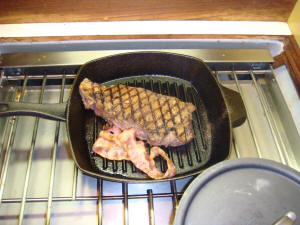 Calphalon Grill Pan |
| Immersion Blender | |
|
Cuisinart Immersion Blender |
Even before I moved onboard I never made much use of blenders and
food processors. Those are effective kitchen tools
for a family or for entertaining, but for cooking for one they are
not that useful. However when sharing the dock in
Cascais with Chris & Dora I watched them prepare a number of great
meals using their immersion blender. For soups, sauces and purees Chris would grab his immersion blender and the job was done. Finally in 2010 I bought a Cuisinart Immersion Blender and have become a convert. |
| Electric Teakettle | |
| This is a 30-year old Kenwood teakettle. I purchased it in the early 80s for home use then moved it to the boat in the late 80s. For awhile it was the Town Creek Marina teakettle as I used the bottom of an old percolator to heat water when dockside. When I purchased Sarah, with its generator, the electric teakettle was once more an onboard device. When dockside I have shore power and using this tea kettle is a no-brainer. |
Kenwood Electric Teakettle |
|
When anchored out I normally start the generator in the morning to
charge the batteries and run the frig. That takes up about 10% of
the generator output. If the hot water heater comes on, that's
another 25%. So I have plenty of capacity to run this tea kettle to
make coffee rather than fire up the propane stove. If you don't
have, or regularly use, a generator this might not be as useful a
device as it is for me. Actually this old tea kettle is nowhere as efficient or as fast to boil water as the newer devices available. I waited for years expecting it to fail so I could get a newer one. In 2013 it was still working, but I gave it away and purchased a newer, more efficient kettle. |
|
| Vacuum Sealer | |
|
I never used a vacuum sealer when living ashore, but I bought one
for the boat when planning the 2001
sail from the Patuxent River to Bermuda. The idea was to
seal some prepared meals (Beef Stew, Spaghetti, etc.) that could be
reheated and provide a meal for all onboard when cooking from
scratch was not the preferred option (rough weather, seasick cook,
inexperienced cook, etc.). I bought a Food Saver unit and it
worked great for that trip. In the picture on the right is my current (2013) Food Saver and some fresh lamb chops and brussel sprouts I have sealed. |
Food Saver with Vacuum Sealed Lamb Chops and Brussel Sprouts |
|
The use on the Bermuda Cruise was such a success I used it again in
2005 when Mike Repass and I sailed from
Florida to Portugal.
At each stop on the trip (The Bahamas, Bermuda, and the Azores) we
used the Food Saver to seal both prepared meals as well as fresh
meat. Those provisions were stored in the freezer or frig
until needed. When I was preparing to sail back to the US in 2007, the old Food Saver gave up the ghost and I had to borrow a unit from another cruiser in Lagos, PT. This time I experimented with using the Food Saver to store food other than in the frig or freezer. Bob Calt and I pre-cooked a lot of rice and pasta and then sealed the cooked items in meal portions and stored them in un-refrigerated lockers. That actually worked very well for over 3 weeks in the cool late spring weather. Finally Bob pulled out one of the last bags of rice from the locker and it looked like a baloon. We discarded the remaining cooked pasta and rice. It appears 2-3 weeks is the limit of how long cooked pasta or rice can be stored without refrigeration even when vacuum sealed, probably less in warmer weather. I've also learned the vacuum sealer can be used for other than food items. When I leave a cold climate for warmer shores I pack most of my sweaters and other cold weather garments in the Food Saver bags and vacuum seal them for the season. The sealer is also useful for electronics. I've made a series of videos of my sailing cruises. I capture and edit the videos on an external HD. When the final video has been produced I vacuum seal the HD with moisture absorbing packets for storage. Eight years of onboard storage later I unsealed one of those HDs and found it to be fully functional. |
|
| Stove Top Smoker | |
| This is one item I never thought I would add to my galley
inventory. I've read numerous articles and recipes that use this type of smoker, but I believed it was not a practical device for onboard cooking. I just assumed that it would fill a small cabin without forced air ventilation with smoke driving the cook and diners to the cockpit. Then one day, I was watching a Cook's Illustrated show on PBS that featured a smoker and they were mildly enthusiastic about it, and there was clearly not a lot of smoke in the kitchen during their demonstration. Surprisingly, within a few days Sur la Table sent me an email with a promotion for stove top smokers. The smallest one they offered was now selling for under $40, down from over $70. So in a moment of weakness I placed an order. Turns out I either read the prices incorrectly or Sur la Table is grossly overcharging. I checked the Carmerons (the manufacturer) website and I could have purchased the same smoker from them for about $30. I never expect to get a discount from Sur la Table, which is why I was such a sucker for their promotion. Turns out I paid the normal Sur la Table markup. Oh well, maybe it wasn't such a good deal, but at least the smoker turned out to be a good product. |
|
|
Cameron's Little Smoker |
The picture on the left shows the base of the smoker on my stove. I have placed a couple of bags of Lapsang Souchang tea in the base to provide the smoke. The smoker came with a couple of small canisters of wood chips, but the Cook's Illustrated folks thought tea smoking produced a better flavor. |
| In
the photo on the right I have placed three blade lamb chops on the
smoking tray in the smoker and partially covered the smoker with the
sliding lid. The lamb chops are seasoned with ground Chipotle. This was not the best meat choice for smoking. Lamb has a strong flavor and doesn't really need to be enhanced with smoke. Better choices are seafood, chicken and pork - all of which absorb flavor while cooking. |
Smoking Lamb Chops |
| So the lamb was not a great success. It was OK, but better
cooked on the grill or sautéed. One thing the smoker does do
for lamb is allow the fat to render off the meat into the pan under
the grill while still keeping the meat moist. I'm also not that sure about using tea for smoking. For me the wood chips provided with the cooker provided better flavors in the cooked meat. I'll still experiment with tea as it is much more readily available than fine wood chips of Hickory, Alder or Mesquite. |
|
|
Smoking Whole Trout |
A better use of the smoker was this whole trout. I smoked it for about 25 minutes. This time I used Hickory chips and no tea. The experiment continues. |
| The picture on the right shows the smoker in operation with the lid closed. You can just see a little bit of smoke coming out from under the lid. My cabin never was "smoked up" and in fact I found the slight smoke odor very pleasant. Sorta like I had a fireplace on Sarah. |
Smoker In Operation |
I have now (April, 2008) used the smoker several times. It has been most successful in cooking seafood, but chicken and pork have come out very well. I particularly like what it does to frozen fish. Being single and cooking mostly for myself makes it difficult to prepare fresh seafood. At a good seafood market they generally don't like to sell part of a fish - that only happens in the supermarkets with plastic-wrapped fish filets in Styrofoam trays. If I buy a whole fish, half of it generally gets discarded unless I eat that fish for 2 or 3 straight nights. It is often more practical for me to buy good quality frozen seafood, but even with good quality frozen seafood doesn't cook up that well. The smoker has provided me with a very satisfying way to prepare frozen fish filets, and I don't have to defrost them. I drop a frozen filet of Mahi-Mahi, Tuna or Cod in the smoker and 25 minutes later I have a very moist and favorable entree for dinner. Of course fresh fish works even better - Salmon in particular. Farm-raised Salmon can be very pleasant (i.e., actually has flavor) when smoked in this manner. I stopped using the the smoker for a little over a year when I left the Chesapeake in the fall of 2008 and spent the winter in the Bahamas. During this period I used the propane grill a great deal and pretty much forgot the smoker was still on board. Then in December, 2009 while berthed in New Bern, NC I re-discovered the smoker. I found Skirt Steak comes out great in the smoker. I also started adding a 1/4 cup of chips on top of aluminum foil under the grate in the oven when cooking frozen pizzas. This gives the pizza much of the flavor of those from restaurants that use a wood-fired oven. Using the smoker or chips in the oven gives the cabin the aroma as if I had a fireplace on board. Very pleasant during the winter holiday period, however I have to be careful how much wood chip I put in the oven. This generates a lot more smoke in the cabin than the smoker. So far the following types of meat appear to work best in the smoker.
|
|
| Here are some of the food items that I have successfully cooked using this smoker | |
|
|
|
I have also used the wood chips on my gas grill. I make a tray out of aluminum foil and place it under the grill grate. After lighting the grill I pour 1/4 cup of chips into the tray then put the grilling meat on the grate. This uses a lot more of the chips than the stove top smoker, but it is only used during the summer months. The experiment continues. |
|
| Thermos Cooker and Sous Vide | |
|
I have also added two special purpose cookers to Sarah's galley, a
Thermos Cooker and a Sous Vide tool. These are both slow
cooking devices that I've adopted for cooking in the cabin during
the hot summer months. My uses for these devices are described
on separate pages. The Thermos Cooker page is
here, and the Sous Vide is
described here. One of the draw backs of the Sous Vide cooker is the need to brown and sear meat after it has been cooked. The meat is fully cooked when removed from the Sous Vide, but it is an un-appealing grey mass until it is browned in a skillet over high heat. My stainless skillet will do the job but it requires leaving the meat in the pan for an extended period before it releases from pan. This tends to over cook some cuts of meat, especially thin steaks and chicken breasts. So Ive replaced my skillet with a non-stick variety. My first choice, another All-Clad, performed as all the non-sticks in the past and was not very durable. My current non-stick skillet is from Greenpan. This uses a ceramic coating and seems to be much more durable. |
|
| Summary | |
|
Reviewing this page in 2019, it is apparent that my claims of having down sized my kitchen equipment since moving onboard are greatly exagerated. I've just described a lot of stuff that many home cooks probably don't have. My current galley inventory includes:
No, clearly I have not down sized at all. At least I'm able to get all this stuff into 2 lockers and 2 drawers, which still leaves a lot of storage space on Sarah. |
|